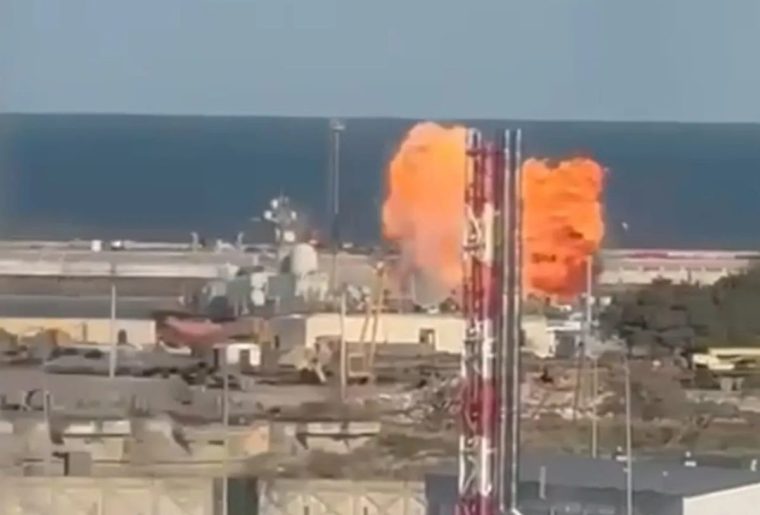Ukraine has launched one of its longest-range strikes of the war, with A-22 “Foxbat” drones striking a Russian naval base in Dagestan at a range of about 1000km (620 miles) from any Ukrainian-controlled territory.
The region had never previously come under fire during the war, and the attack on Wednesday appeared to have taken Russian forces by surprise.
Soldiers at the base in the city of Kaspiysk were filmed trying to shoot down the drones with machine guns. Russian military blogger Two Majors reported “chaos and confusion” at the scene.
The attack marked the latest demonstration of the advancing powers of Ukraine’s military industrial complex, at a time when support from the US is uncertain following the election victory of Donald Trump.
The president-elect has criticised military aid packages to Ukraine, and his team are reportedly considering a peace plan that would require Ukraine to surrender territory.
Ukrainian officials have increasingly emphasised a message of self-reliance to reduce dependence on foreign allies, and bypass restrictions that come with Western weapons.
Ukrainian Prime Minister Denys Shmyhal said in October: “Among our strategic tasks is to strengthen the long-range capability of Ukrainian weapons, so that there is no safe place in the European part of Russia where..our drones and missiles could not reach.”
Ukrainian President Volodymyr Zelensky said recently that Ukraine had built a “virtually new defence industry” during the war. The budget for 2025 includes 2.2trn hyrvnia (£41bn) for defence spending, almost two-thirds of the total planned expenditure of 3.6 trn (£67.3bn) hyrvnia.
Drones have been critical to Ukraine’s war effort. More than 200 new companies have launched since February 2022, according to the government, supplying the military with capabilities for land, air and sea that have helped to bridge Russia’s advantage in conventional warfighting equipment such as artillery and fighter jets.

Ukraine can now produce four million drones a year, Mr Zelensky said last month, including long-range models such as the A-22, and the “Sea Baby” marine drones said to be capable of carrying a one-tonne warhead for 1,000km.
Kyiv is also producing its own missiles, such as the Neptune anti-ship missiles used to sink the flagship of Russia’s Black Sea Fleet, Moskva, in April 2022, which are being repurposed to attack targets on land. Defence officials say the first home-made ballistic missiles will enter service in 2025.
Ukraine is manufacturing millions of mortar shells a year, a cheaper alternative to artillery, up from zero before the war, Strategic Industries Minister, Herman Smetanin, said last week, adding that further expansion was only held back by a global shortage of explosives. The military also recently started production of 155mm artillery shells.
Ukraine’s domestic weapons programmes can continue to expand and produce more effective weapons through a loss of US support if European partners remain committed, said Mykola Bielieskov, an adviser to Ukraine’s military leadership at the National Institute for Strategic Studies think tank in Kyiv.
“If Europe can finance all these programmes through at least the interests of Russia’s frozen assets, then we can be certain of indigenous programmes,” he said, listing drones, missiles, mortar and artillery shells as priority areas for growth.
Mr Bielieskov said the quality of arms, such as the range and power of warheads, would continue to improve, but greater investment is required from partners to scale up manufacturing.
“Rate of production is the most challenging thing,” he said.
But in some key areas such as air defence and ammunition for Himars rocket launchers “there is huge dependence on the US”, Mr Bielieskov added.
“I hope Europe can secure these things through direct purchase from the US.”
Oleksiy Goncharenko, a Ukrainian MP with the European Solidarity party, said contingency plans exist for a drop in US support but suggested that it would be difficult to develop Ukraine’s defence industry without it.
“Of course, there is aid from the EU, but it will definitely not be enough,” he told i.
The MP expressed hope that the Trump adminstration could be persuaded that support for Ukraine is in US economic interests.
“After all, it is American companies that receive orders for weapons and other types of assistance for Ukraine. And these are huge enterprises, which means that they employ a lot of people,” he said.
Dr Marina Miron of the Defence Studies department at King’s College London expressed doubt whether Ukrainian industry could keep up with the demands of war without US support.
“The problem is not innovation, it’s the scaling of production,” she said. “Research and development is one thing, but the other is delivering the goods in numbers and keeping up with the timeline that is required, and it’s very, very difficult.”


